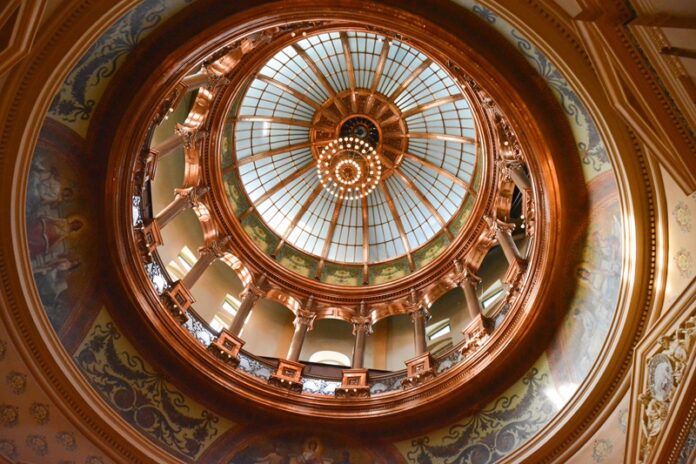Kansas state government doesn’t have a process requiring state agencies to analyze the benefit of leasing or purchasing office space, raising questions about whether the space acquired is used effectively and efficiently, a new audit shows.
Overall, 78 state agencies reported an inventory of 4.1 million square feet of office space across 524 locations statewide, of which 2.6 million, or 63%, is leased, the audit said.
State agencies leased most of their space in Shawnee County, about 1.6 million square feet compared to about 982,000 square feet in other Kansas counties.
The audit also found that nearly all state leases for privately owned space were less expensive than leases for state-owned space.
The average cost to lease privately owned space was about $21 per square foot, while the average cost to lease state-owned space was $25.40 per square foot, the audit found.
The Department of Administration didn’t dispute the disparity between the rent paid to a private landlord and the state, but it said there were nuances that explained the difference.
“Kansas doesn’t have a regimented, formal process where a single agency examines agencies’ needs and determines the best option for both square footage and leasing versus owning,” the audit said.
“Instead, agencies have a lot of discretion in determining what works best for them.
“As a result, we can’t say whether agencies are acquiring and using that space as efficiently or effectively as they could, because each agency’s circumstances are different,” the audit said.
The audit reported that the Department of Administration doesn’t systematically evaluate if state agencies are making the most cost-effective decisions when they select office space.
“Instead, state agencies decide what locations are best for their agency on a case-by-case basis,” the audit said.
The audit said agencies generally must receive approval from either the Department of the Administration or Legislature for the space they choose.
“But those approvals are high-level and don’t compare detailed costs or non-financial factors across available options,” the audit said.
The audit questioned why state agencies paid about $4 less per square foot to lease state-owned space than private space.
“We can’t fully explain why the state lease cost generally appears to be more than private lease costs,” the auditors reported.
The audit suggested a number of possible reasons, including the age or condition of the state buildings or that the Department of Administration may not be calculating state lease costs correctly.
“Finally, it’s also possible some agencies reported fewer occupancy expenses than they actually have,” the audit said.
“For instance, they may not have included additional costs for parking or security services even though we asked them to. This would make the total cost-per-square-foot lower than it actually is,” the audit said.
“However, we don’t have any reason to think that agencies consistently underreported these amounts in a way that would significantly change our conclusion.”
Auditors said the annual cost to own space in Topeka was not known because few agencies own space and the Department of Administration’s data for state-owned office buildings wasn’t reliable.
Auditors said they tried to collect cost data from agencies that own their office space so they could compare purchasing costs to leasing costs.
“However, only a few agencies with office space in Topeka own their locations and they reported no debt service costs remain for those spaces,” the audit said.
“This means those agencies’ costs aren’t a good approximation for what it would cost state agencies to purchase a new building.”
Auditors said they couldn’t analyze the cost data that was provided by the Department of Administration for fiscal years 2022 through 2024 because it wasn’t reliable.
“We identified a series of calculations and numbers that didn’t make sense and that DOA officials couldn’t explain,” the audit said.
“For example, several totals didn’t sum correctly or conflicted with other subtotals, overhead costs were inconsistently allocated, some salary expenses and debt service costs were incorrect, and several expense categories…varied significantly across years.”
The auditors said the Department of Administration couldn’t resolve the issues they identified in their cost data because of frequent staff turnover.
Auditors said the Department of Administration offered several reasons about why the state lease rate would be higher than private space. They included:
- The department said the state lease rate includes the cost to cover future building improvements, meaning agencies that lease state-owned space pay a portion of improvement costs even when those improvements don’t involve their agency.
- The department said the state rate included the cost of nonleasable space – such as cafeterias shared across agencies leasing the space – in six state-owned office buildings as well as debt service for two of those buildings. About 25% of the space in four of the buildings is nonleasable.
- The department said it provides services or amenities that private lease-holders may not offer, including access to exercise areas and the network fiber loop and virtual server platform managed by the Office of Information Technology Services.
The Department of Administration did not dispute the disparity between the rents for leased private property compared to rents for state leases.
In responding to the audit, the department said the costs captured for private leases reflect the rates that tenants are paying in fiscal year 2025 based on their current lease agreements, many of which were signed years ago.
“These rates reflect what the market would assess at the time the lease was negotiated, and it might not match what the market would assess today,” wrote Adam Proffitt, secretary of administration.
As an example, Proffitt said that if a tenant were currently paying a lease rate of $18 a square foot with a lease that expires Dec. 31, 2026, then the landlord might not be willing to offer the same rate per square foot for that space in January 2027.
“We have seen dramatic upward shifts in the cost of real estate over the past five years, as is reflected in housing and commercial prices all across the state,” Proffitt wrote.
“Many of the leases identified in the underlying data set for this section of the audit expire in the next two years, meaning agencies will need to negotiate rates with these landlords to extend their lease agreements, or will need to find new space.”













